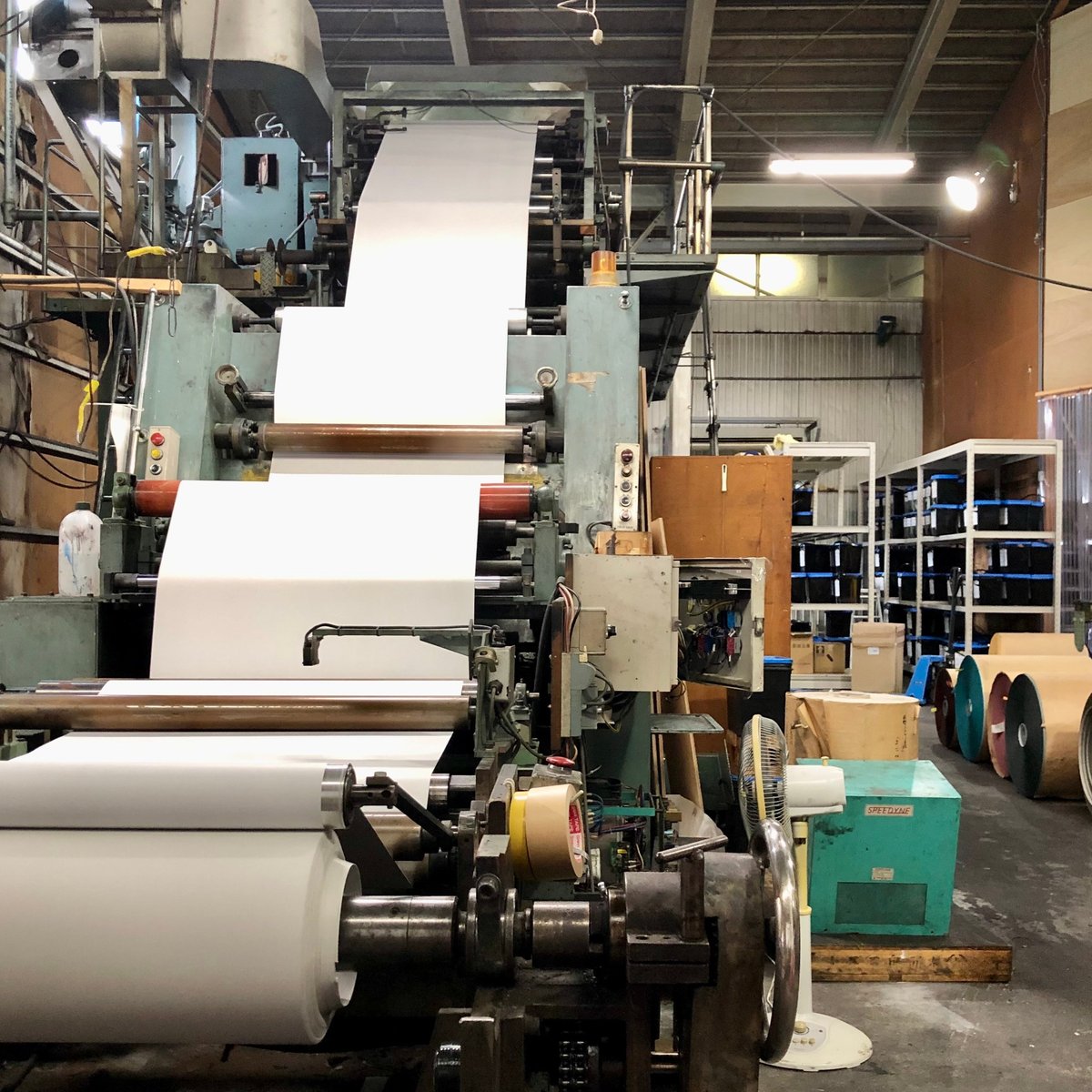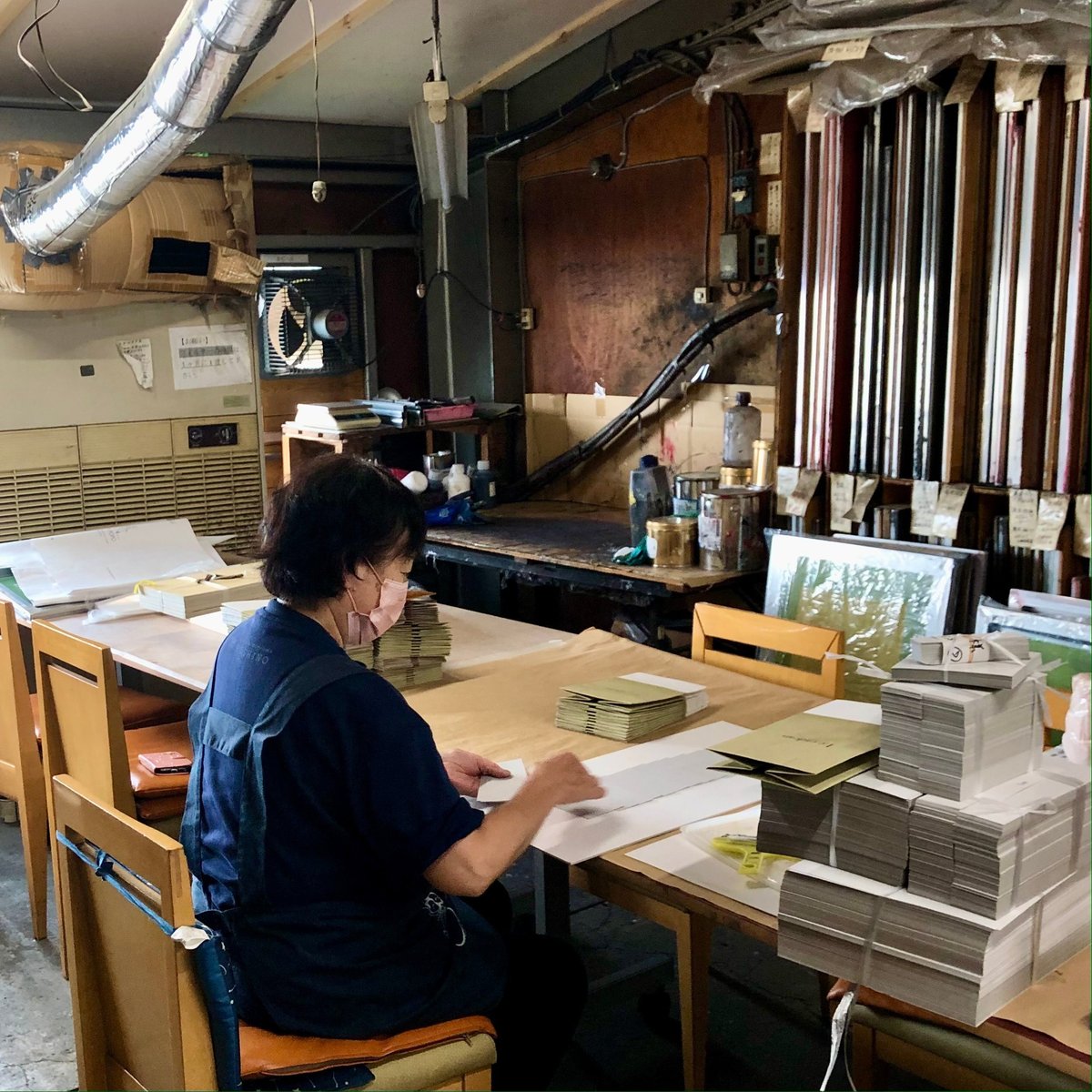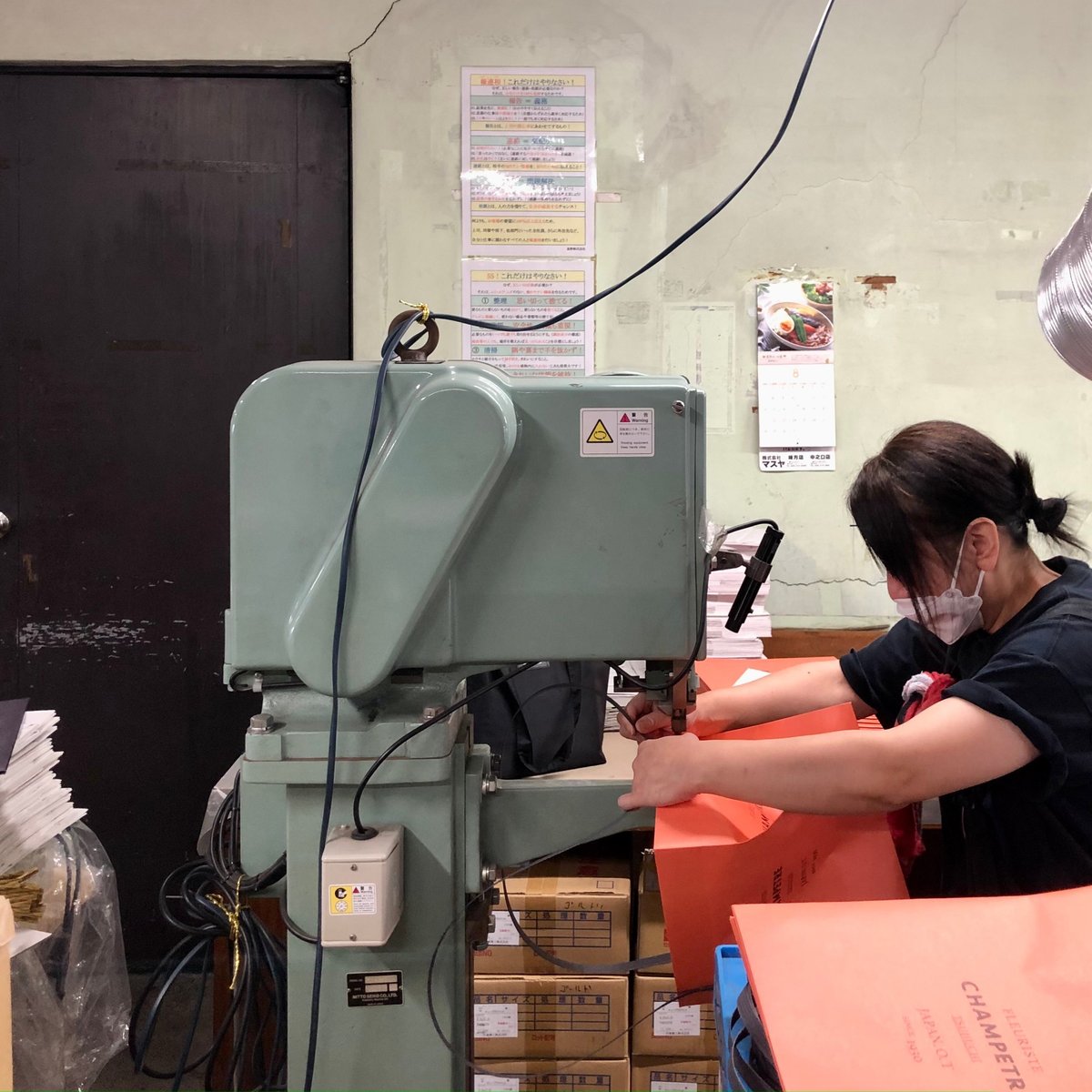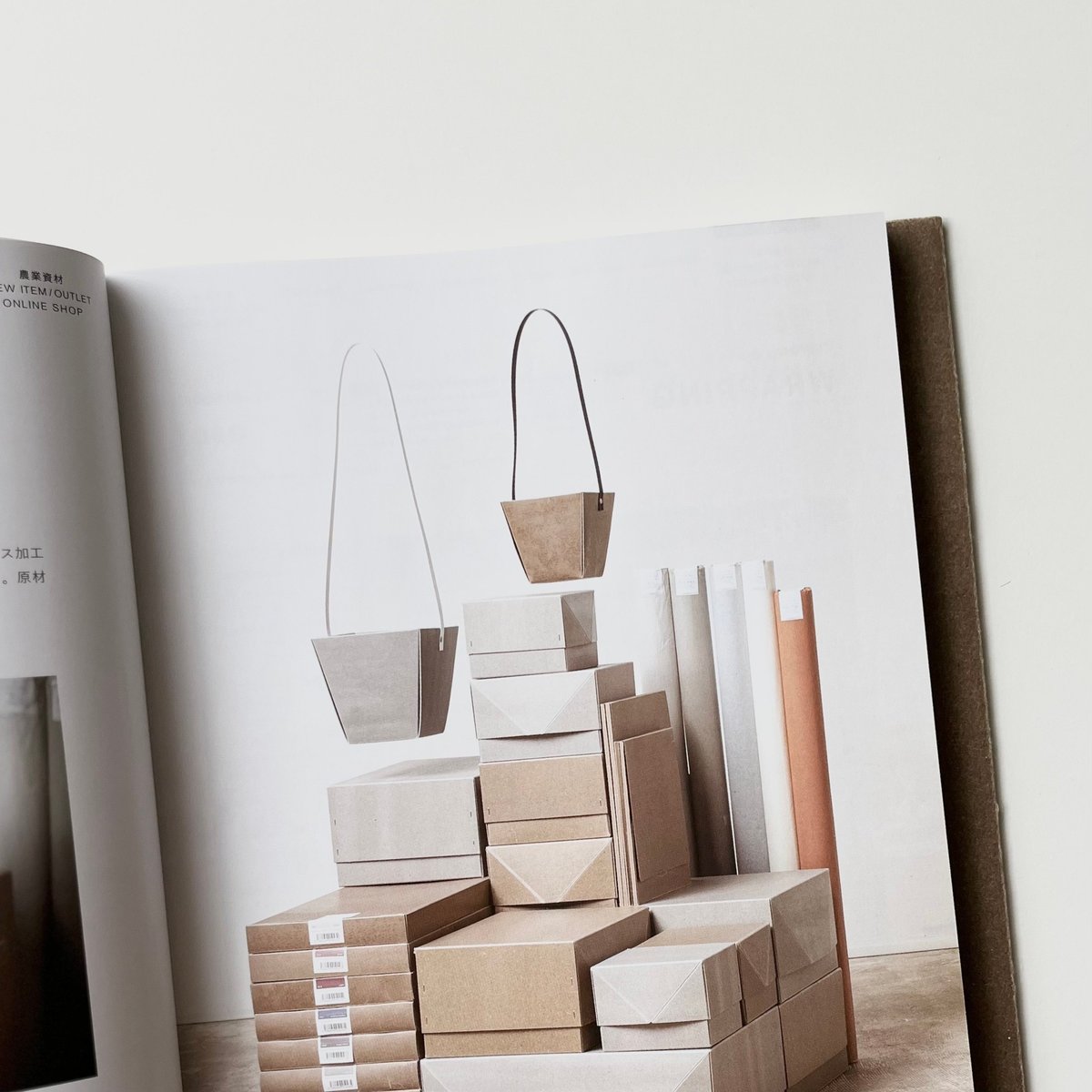
第3回 星野株式会社 The 3rd Hoshino Co.
「今ある技術の掛け合わせと知恵と工夫を凝らし新しい素材を提案していく秘密基地です」という言葉を掲げているとおり、タケノマルは場所であるとともに新しい素材を提案・開発する”ものづくりチーム”でもあります。今回はチームのパートナーである〈星野株式会社〉について紹介したいと思います。
As the company's motto states, "Takenomaru is a secret base for proposing new materials by combining existing technologies and applying wisdom and ingenuity," Takenomaru is both a place and a "manufacturing team" that proposes and develops new materials. In this issue, we would like to introduce the team's partner, Hoshino Co.
〈星野株式会社(以下ホシノ)〉は1935年に創業し、果実袋の製造・販売を開始しました。果実袋とは、生育期の果実を包み、強い太陽光・風雨・葉擦れなどから保護するためのもので、紙袋に殺菌・ワックスなどの特殊な加工を施しています。袋を用いずに栽培した場合と比べてキズが少ないため、より長く保存することが可能になります。その遮光性や透湿性は、糖度や色づきを左右する重要な要素となるので、一口に果実袋と言っても果実や用途によって種類はさまざま。ホシノではブドウ用だけでも23種類の果実袋を製造しています。1979年には新たにパッケージ・手提袋の製造を開始し、1999年には花資材部を設立しました。現在のホシノのパブリックなイメージを担っているのはこの花資材部でしょうか。
Hoshino Co. (Hoshino) was founded in 1935 and began manufacturing and selling fruit bags. Fruit bags are used to wrap fruit during the growing season and protect them from strong sunlight, wind, rain, and leaf rubbing, and are made of paper bags with special treatments such as sterilization and waxing. The fruit is less flawed than when grown without bags, allowing it to be stored longer.Since their light shading and moisture permeability are important factors that affect sugar content and coloring, there are various types of fruit bags, depending on the fruit and application. Hoshino manufactures 23 types of fruit bags for grapes alone. In 1979, Hoshino began manufacturing new packaging and handbags, and in 1999, it established a floral materials division. It is probably this floral material department that is responsible for Hoshino's current public image.
COOを務める星野誠さんと堀木の出会いは2020年のこと。常に何か新しい試みに取り組んでいるホシノですが、その頃はラッピングペーパーを作る度に発生してしまう端材を活用することはできないものかということで、オリジナルのおりがみを開発していました。誠さんはそのおりがみを入れるための箱を作りたいと、竹内紙器製作所を訪れたのでした。ふつうであれば箱作りの相談にきた誠さんの方からいろいろ質問をするものですが、誠さんが参考のために持ってきたホシノの商品や原紙のサンプルを見て、質問攻めにしたのは堀木の方でした。誠さんのものづくりへの情熱と真摯な姿勢、そして初めて見る紙や素材が、堀木の”ものづくり魂”に火をつけてしまったのです。それが縁の始まりで、その年の6月には堀木をはじめ竹内紙器の社員数名でホシノの工場を見学させてもらうことになりました(おりがみの箱はのちに無事できあがり商品化されました)。
Mr. Makoto Hoshino, who serves as COO, and Horiki first met in 2020. Hoshino is always working on something new, and at that time they were developing an original origami wrapping paper to see if they could make use of the scraps of wood that are generated every time wrapping paper is made. Mr. Makoto visited Takeuchi Shiki Seisakusho to make a box to hold the origami. Normally, when Mr. Makoto came to consult with Takeuchi Shiki about making a box, he would have asked many questions, but when he saw samples of Hoshino's products and base paper that Mr. Makoto had brought for reference, it was Horiki who asked the most questions. Mr. Makoto's passion and sincerity for craftsmanship and Seeing the paper and materials for the first time ignited Horiki's "craftsmanship spirit". This was the beginning of a relationship, and in June of that year, Horiki and several Takeuchi Shiki employees were invited to visit Hoshino's factory (the origami boxes were later successfully produced and commercialized).

ホシノの社屋と工場は新潟県新潟市南区にあります。全国的にもよく知られる燕市や三条市と接する、ものづくりの盛んな地域です。横浜から電車で向かえば最寄りはJR燕三条駅になりますが、堀木はどこへ行くにも愛車を走らせます。三条燕ICで北陸道を降り、中ノ口川と信濃川に挟まれ、両側に果樹園が並ぶ国道8号線を北へ15分ほど行くと左手にホシノの建物が現れます。靴を脱いで上がるオフィスは明るくて清潔で、誠さんをはじめCEOの星野敬司さん、CFOの星野智洋さんが迎えてくれました。
Hoshino's company building and factory are located in Minami-ku, Niigata City, Niigata Prefecture. This is a thriving manufacturing area bordering the nationally well-known cities of Tsubame and Sanjo. If you take the train from Yokohama, the nearest station is JR Tsubame-Sanjo Station, but Horiki drives his car wherever he goes. After exiting the Hokuriku Expressway at the Sanjo-Tsubame Interchange, drive 15 minutes north on Route 8, which is flanked by orchards on both sides by the Nakanoguchi and Shinano Rivers, and the Hoshino building will appear on your left. The office, where we took off our shoes, was bright and clean, and we were welcomed by Mr. Makoto, CEO Mr. Keiji Hoshino, and CFO Mr. Tomohiro Hoshino.

挨拶もそこそこにさっそく工場を案内してもらいました。工場のある敷地は社屋も含めて1,700坪あり、これはサッカーコートに換算すると0.78個分、といっても余計にピンときませんが、ひとりでウロウロしていると迷ってしまうほどの広さです。工場の中にはホシノが展開する商品を作るための、ありとあらゆる機械がありました。印刷機、蝋引機、撥水機といった機械の巨大さに圧倒され、ブドウ袋やリンゴ袋などを作る製袋機がずらりと並ぶ様は壮観でした。そして蝋引、撥水、エンボス、印刷など様々な加工が可能であるということは、堀木にとってとても興味深いことでした。このときすでに頭の中には"ストレージ"のカラーバリエーションを作るというアイデアがあったとかなかったとか。
Immediately, We were immediately taken on a tour of the factory. The factory site, including the company building, is 1,700 tsubo (about 5,600m2), which is equivalent to 0.78 soccer courts, but it is so large that you would get lost wandering around by yourself. Inside the factory, there were all kinds of machines used to manufacture Hoshino's products. We were overwhelmed by the huge size of the printing presses, waxing machines, and water repellent machines, and the lineup of bag-making machines for making apple and grape bags was spectacular. It was very interesting to Horiki to see the various processing capabilities, such as waxing, water repelling, embossing, printing, etc. At that time, he may or may not have had the idea of creating color variations of "storage" in his mind.







また、ホシノがもともと農業用資材として扱っていた育苗紙や桃袋に使用していた抄き合わせの紙は、新鮮な発見でもありました。育苗紙とはその名のとおり、苗を育てる際に土をこぼさず、根が箱の外に伸びないように、育苗箱の底に敷くものです。苗の移植をする際に根切りをせずにすみ、敷いたまま植えても自然分解されます。一見すると新聞紙や藁半紙のようでいて、手触りはしっとりとしてなめらか。桃袋の上部には口を開けやすくするための、ホットメルトによる滑り止めが赤い点で施されていて、デザイン的にもよいアクセントになっていました。機能をシンプルに満たしたものは、時として意識せずとも美しさを伴ってしまうものです。のちに、育苗紙に会社概要を印刷したものを桃袋に紙見本と一緒に入れて、竹内紙器製作所の会社案内としてしまったくらいです。
The paper used for seedling paper and peach bags, which Hoshino originally handled as agricultural materials, was also a fresh discovery. Seedling paper, as the name implies, is used to lay the bottom of a seedling box to prevent soil from spilling when growing seedlings and to prevent roots from extending outside the box. When transplanting seedlings, the roots do not need to be cut, and the paper decomposes naturally even if the seedlings are planted while it is still laid on the box. At first glance, it looks like newspaper or straw paper, but it is moist and smooth to the touch. The top of the peach bag has a red dot with a hot-melt non-slip surface to make it easier to open the mouth, which was a nice design touch. Sometimes, a simple functional item can also be beautiful, even if we are not aware of it. Later, I printed the company profile on seedling paper and put it in the peach bag along with a paper sample, and used it as Takeuchi Shiki Seisakusho's company brochure.



そんな堀木の視点を元にして、ホシノはフレキシブルかつスピーディーに商品化を果たしました。それが”ESPRIT(エスプリ)”シリーズです。もともと製造の要であったワックス加工をボール紙にも応用してパッケージを作りました。そのために新たにアームステッチャー、筋押機、カラス切り機、活版印刷機を導入して体制を整えてもいます。桃袋の原紙は撥水加工を施してラッピングペーパーへと生まれ変わりました(もちろん桃袋としても継続&人気)。さらに2021年には、ホシノにとってその年の業績を左右する最も重要なアイテムともいえる、製品カタログのディレクションに堀木が携わることになりました。その中でも目を見張るのは、誌面に撥水加工を施した育苗紙を使用していることでしょうか。テキスタイルのようなテクスチャー感が特徴的です。もともとの使用目的に捉われないアイデアが、新しい素材を生み出したといえます。育苗紙に撥水加工を施す技術はもちろんホシノのエクスクルーシブ。
Based on Horiki's point of view, Hoshino has achieved flexible and speedy commercialization. This is the "ESPRIT" series. The wax process, which was originally the cornerstone of the manufacturing process, was applied to cardboard to create the packaging. For this purpose, we have newly introduced an arm stitcher, a streak press, a raven cutter, and a letterpress printer. The original paper for peach bags was treated with a water-repellent finish and transformed into wrapping paper (which, of course, continues & is popular as peach bags). Furthermore, in 2021, Horiki will be involved in the direction of the product catalog, the most important item for Hoshino in terms of the year's performance. Perhaps one of the most striking features is the use of water-repellent nursery paper for the magazine. It has a textile-like textured feel. It can be said that an idea that is not bound by the original purpose of use has created a new material. The technique of applying water-repellent treatment to seedling paper is, of course, exclusive to Hoshino.



こうして竹内紙器製作所と星野株式会社は素材開発を協働で行うようになり、タケノマルへと繋がっていくことになります。
Thus, Takeuchi Shiki Seisakusho and Hoshino Co. began to collaborate on material development, leading to Takenomaru.
星野株式会社|https://hoshino-co.com/
この記事が気に入ったらサポートをしてみませんか?
